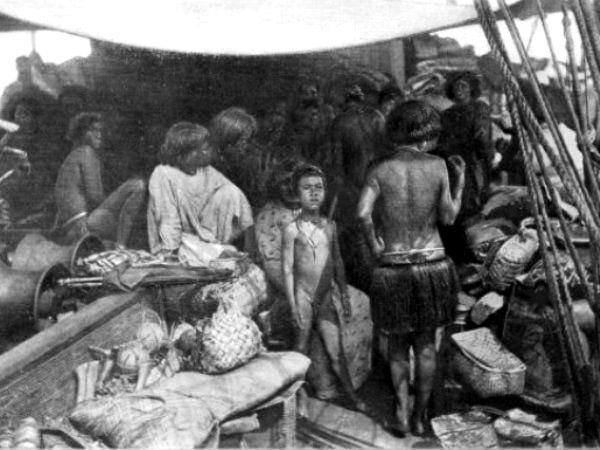
Kiribati History

Figure 1.--Here the family of Tem Binoka is seen on board the ship 'Janet Nichol' (1889). They are traveling from Aranuka to Abemama in the Gilbert Islands. Tem Binoka was the last truly independent king of Abemama, Kuria and Aranuka. He reigned from 1878-91. The boy in foreground is probably Paul, son of Tem Binoka's brother. He will become the last nominal king of Abemama, Kuria and Aranuka.
|
|
Kiribati consists of a chain of widely separated islands in the Central Pacific Ocean straddling the equator, about half way between Hawaii and Australia. Kribati is primarily made up of the Gilbert Islands, but includes the Line Islands and Phoenix Islands. It was part of the British Gilbert and Ellice Islands Colony. Spanish explorer Pedro Fernandex de Quiros discoversed Butaritari and named it Buen Viaje (1606). Other islands were subsequently discovered (18th abd early-19th centuries). The substantial distance between the islands meant that they were discovered piecemeal. Russian hydrographer Krusensten named then the Gilberts (1820), European traders and missionaries begin visting the Gilberts (mid-19th century). The British appointed a Governor of Fiji as High Commissioner for the Western Pacific (1877). This gave the governor jurisdiction over British subjects. His authority was exercised through British naval commanders. Captain E.H.M. Davis on the HMS Royalist proclaimed the Gilberts group a British protectorate at Abemama. After the British flag is also raised over Tuvalu, a new protectorate is established at Butaritari (1892). The British annexed Bnaba after the discovery of phosohate (1900). The Banaban phosphate became so important that the British transfer the Protectorate's headquarters to the island. After consulting with the native king during World War I, Britain annexed Gilbert and Ellice Islands by an Order-in-Council (1915). The Gilberts did not play a role in World War I, but there proved to be a very different situation in World War II.
Shortly after Pearl Harbor, the Japanese occupied the Gilberts (early-1942). After the United States stopped the Japanese advance in the Pacific War at Midway (June 1942) and then launced America's first offenive of the War. Marines in the South Pacific landed on Guadalcanal (August 1942). The U.S. Navy after savage fighting in the Solomons, opened another front--the Central Pacific. This began in the Gilberts. Just as Guadalcanal had ben the furthest dvance south toward tge merican-Austrlian se lanes, thecGilberts were the firt advance east toward Hawaii. The Japanese heavily garisoned Tarawa and believed that such a well-defended bastion could fight off an amphibious attack. They were nearly correct. The heavily maulded Imperial fleet, however, did not intervene. For a bloody few days, the American press focused on the Gilberts. The Battle of Tarawa was a shocking affair, but proved the U.S. Marines could take even a strongly fortified islsnd. The military believed that photograohs of the battlefield carnage was too shocking for the American public to see. President Roosevelt decided that it was important for the public to know what was happening. The Navy used Tarawa as a learning experience and future landings were much better orcestrated. The Ellice Islands separated and became the independent nation of Tuvalu (1978). Britain granted self-rule to the Gilberts (1971) and complete independence as Kiribati (1979).
HBC

Navigate the Boys' Historical Clothing Web Site:
[Return to the Main Oceania history page]
[Return to the Main Kiibati page]
[Return to the Main Oceania page]
[Introduction]
[Activities]
[Biographies]
[Chronology]
[Cloth and textiles]
[Clothing styles]
[Countries]
[Topics]
[Bibliographies]
[Contributions]
[FAQs]
[Glossaries]
[Images]
[Links]
[Registration]
[Tools]
[Boys' Clothing Home]
Created: 5:51 PM 2/28/2012
Last updated: 2:18 AM 3/7/2012



